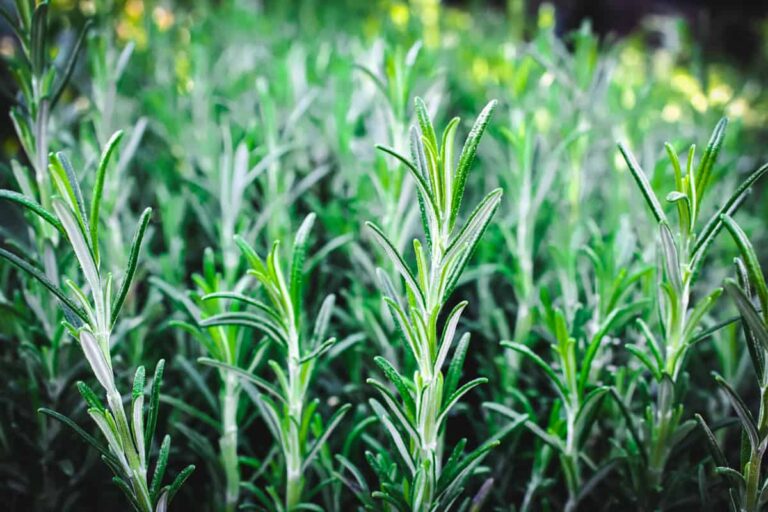Ah, the delightful Rosemary plant, Salvia rosmarinus, is a fragrant herb that’s sure to elevate any dish with its aromatic leaves. This perennial, rounded evergreen shrub features needle-like, gray-green leaves on erect woody stems. And come late spring to early summer, it produces clusters of small, light blue to white flowers that add a pop of color to any garden.
While it’s best to plant Rosemary in the spring after any threat of frost has passed (just like in the case of pumpkins), you can grow it indoors too. Just be warned, it can grow quite large!
Most common Rosemary varieties:
- Tuscan Blue Rosemary: This variety is known for its tall, upright growth habit, and its large, deep blue flowers.
- Spice Island Rosemary: This type of Rosemary has a more prostrate growth habit, with short, densely packed leaves that are highly aromatic.
- Barbeque Rosemary: As the name suggests, this variety of Rosemary is often used in grilling and barbequing due to its strong flavor and aroma.
- Salem Rosemary: This is a popular cultivar that is known for its cold-hardiness and its ability to grow in a wide range of soil types.
- Arp Rosemary: This variety is prized for its cold-hardiness and ability to withstand harsh winters, making it a favorite among gardeners in colder climates.
Care
If you’re looking to keep your Rosemary plant thriving, there are a few key things to keep in mind. First and foremost, this herb requires plenty of direct sunlight, so be sure to plant it in a spot that gets at least six hours of sun per day. If you’re growing it indoors, a south-facing window and supplemental grow lights can help to provide the necessary light.
- Water: be careful not to overwater your Rosemary; it prefers to dry out between waterings, and it’s better to underwater than to overwater.
- Soil: Make sure the soil is well-draining and slightly acidic to neutral, with a pH between 6.0 to 7.0.
- Light: requires plenty of direct sunlight, so be sure to plant it in a spot that gets at least six hours of sun per day.
- Temperature: When it comes to temperature, Rosemary is a bit of a Goldilocks – it doesn’t like it too hot or too cold! In fact, this herb prefers cooler temperatures during the day, ranging from 60 to 65 degrees Fahrenheit. At night, it likes things even cooler, with temperatures between 40 to 50 degrees Fahrenheit. By keeping your Rosemary in its preferred temperature range, you can ensure it stays happy and healthy.
Propagation
If you’re looking to propagate your Rosemary plant, the most common method is through stem cuttings. To do this, take a cutting from the tip of a healthy stem, making sure it’s about 3 to 4 inches long and has several sets of leaves. Remove the lower leaves from the cutting, leaving only a few at the top. Dip the cut end in rooting hormone, and then plant it in a well-draining potting mix. Keep the soil moist, but not too wet, and place the cutting in a warm, bright location.
Common Pests
- Aphids
- Leafhoppers
- Spider mites
- Spittlebugs
- Thrips
- Whiteflies
Frequently Asked Questions
Growing Rosemary is generally easy, especially in warm, sunny areas. This herb is low-maintenance and drought-tolerant, but be sure not to overwater or use overly moist soil to avoid problems like root rot. With proper care, growing Rosemary can be a rewarding experience!
Where does rosemary grow best?
Rosemary grows best in warm, sunny climates with well-draining soil. It can be grown both indoors and outdoors and is a low-maintenance and rewarding herb to cultivate.
Does rosemary grow all winter?
Rosemary is a hardy evergreen perennial that can continue to grow throughout the winter in mild climates. In areas with harsh winters, however, it may enter dormancy or suffer frost damage and require additional protection to survive.
How long can rosemary live?
Rosemary is a long-lived plant and can potentially live for many years with proper care. In ideal growing conditions, Rosemary can live up to 20 years or more.
How often do you water rosemary?
To avoid problems with your Rosemary, it’s important not to water it too much. Allow the top few inches of soil to dry out between waterings. If there is no rain, every few days should be fine for watering.


